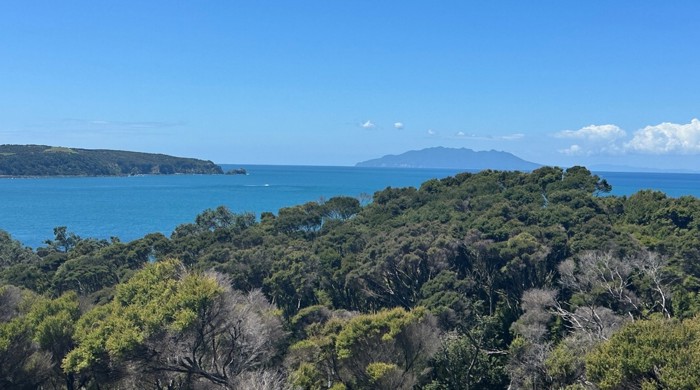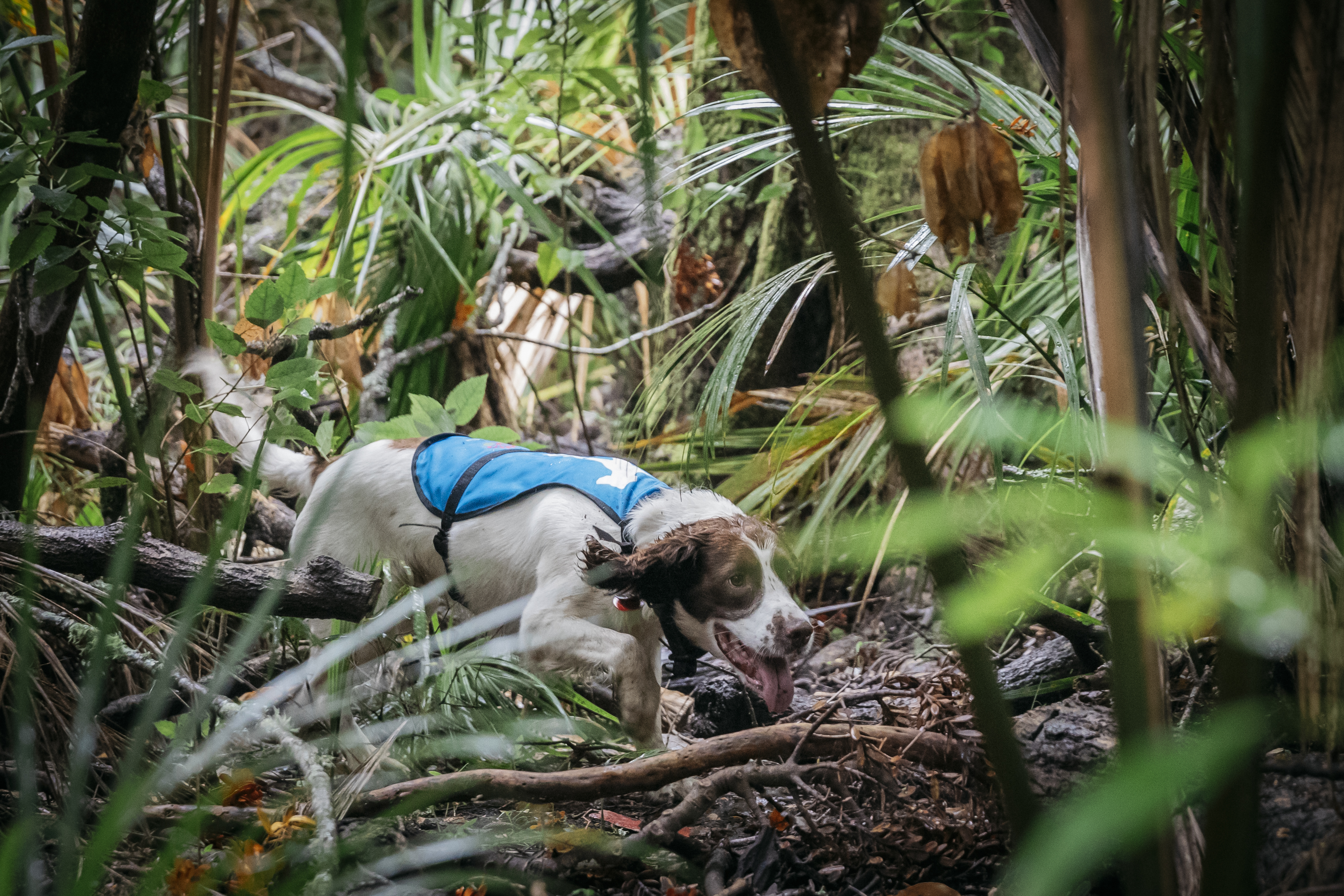Ngā pūrongo o Kawau
Kawau news and key safety information
Find project newsletters and access key safety factsheets for the Kawau Island pest eradication project.
Introduction
The success of this programme, initially and long term, depends on the support and involvement of Kawau Island’s community. Auckland Council is committed to working with you, keeping you up to date and listening to your feedback.
This is your page to keep up with all the important news on the Kawau Island pest eradication programme and some of the environmental outcomes we hope to celebrate in the future.
Email us to sign up for the project newsletter. See the operational updates section for the latest information.
Safety factsheets
Information for landowners and occupiers
The project team have prepared a factsheet outlining important information for landowners, occupiers and visitors to the island. It contains key information that is important to read.
Kawau Island landowner factsheet (PDF 1MB)
Keeping dogs safe
Dogs are the most at-risk pets during a 1080-based pest control operation. Always supervise your dog and keep them on a leash in affected areas. Do not let them roam or eat animal remains. Consider using a muzzle. If you suspect your dog has eaten 1080 poison, make the dog vomit immediately if possible and call your vet straight away.
For those on the island, this is likely the Warkworth Vets – 09 425 8244
Alternatively, contact the Auckland Council call centre (24 hours) – 301 0101 for locations of emergency emetic medication.
Check out the dog protection factsheet (PDF 833MB) for further information.
Safety tips
During the operation and six months afterward:
• do not touch bait that is dyed green
• watch children at all times
• keep dogs away from poison baits and animal remains, as 1080 they are toxic to animals
• read and follow all safety signs.
National Poisons Centre
If you think someone has been poisoned, call the New Zealand National Poisons Centre immediately - 0800 764 766
Contact
Email us at kawauislandproject@aucklandcouncil.govt.nz

Latest update: 17 October 2025 newsletter
Working towards a pest free Kawau Island
Operational update
Putting lessons learnt into practice and testing assumptions
The primary methods for the ground-based operation to eradicate possums and wallabies continue to be hunting – supported by the use of thermal devices and dogs, and the targeted application of toxins (1080 and Feratox) in areas where the monitoring network has revealed higher numbers of wallabies and possums are still present.
Progress snapshot:
- 327,011 images captured and analysed
- 167 possum traps set (in Block 1)
- 285ha covered by possum dogs
- Over 1,230 wallabies removed by thermal assisted hunting
- 172 possums removed
Our first targeted ground-based treatment of 1080 and Feratox took place between 19 - 23 July this year in the southern half of the island, excluding residential areas and block one (largely Mansion House Reserve and adjoining DOC land).
What have we learnt?
- Wildlife cameras have detected possums in all blocks (1–10), confirming their presence across all of Kawau. Block 1 has the highest possum population, but good progress is being made with the assistance of the possum indicator dogs.
- The field cameras and drone surveys have revealed that wallaby numbers are higher than originally anticipated across the island as a whole. Hunting block one has transitioned to a mop up phase with a focus on last remaining individuals.
- Resting of hunting blocks between rotations becomes important when focusing on removing the last surviving animals.
- The toxin operation ran smoothly and without incident, and our pre- and post-treatment monitoring indicated a reduction in numbers. However, the operation did not reduce numbers to the extent that we anticipated.
- The technical advisory group met to discuss the results and likely influencing factors to help refine our approach. This includes differences in animal behaviour observed for darma wallabies compared with swamp and dama wallabies (where much of the current wallaby management research in NZ has focused to date).
- Wallaby populations in the southern sector of the island consist of predominantly darma and swamp wallabies. Parma have been observed to have smaller territories and may demonstrate differences relating to bait palatability.
Next steps
- A small-scale trial is now planned for the remote Challenger Point Peninsula in the southeast of the island (see figure 1), which will be fenced and monitored for the duration of the application. In accordance with permit requirements, warning signs will be placed at potential entry points to each management area/ block and at individual sites where bait is laid. The trial will test assumptions relating to alternative food availability, wallaby behaviour, bait palatability (introducing cut foliage with 1080 gel as a lure) and presentation. We aim to begin towards the end of October/early November, during the first suitable weather window after Labour weekend.
Reminder about Key Safety Information
- Information relating to the inclusion of cut foliage with 1080 gel in addition to cereal bait has been updated in the project factsheets (see above).
- Precautions for safeguarding public health during the treatment window and protecting your dogs throughout the cautionary period remain the same.

Figure 1: Planned trial location with additional temporary fence line designating the treatment area
Update on hunting and trapping progress across the island
Block 1: DOC Historic & Stoney Hill Recreational Reserves – Night Hunting
Night hunting with thermal drone support in the DOC-managed Historic and Stoney Hill Recreational Reserves is tentatively scheduled to occur during the following periods (if necessary and subject to wildlife camera data):
- 28 October to 7 November 2025
- 24 November to 5 December 2025
These hunting operations in the DOC reserves will focus on targeting individual wallabies and hot spots of activity. Final confirmation of these dates will be communicated to neighbouring residents and landowners.
Block 2: Possum Team Coming Through South Cove Next Week
To date, no possums have been detected in South Cove through wildlife cameras, thermal imagery, or drone surveys. To confirm this, Cam Gray and Kiri Stack with possum indicator dogs Cossie and Beck will be conducting a daytime ground survey through South Cove residential areas and the coastal cliffs on October 23rd and 24th. Cam & Kiri will need three sweeps to fully confirm the absence of possums – one of these checks will be when the pōhutukawa trees are in full flower.

Figure 2: Qualmons Possum dog Beck (handler – Kiri Stack), in action, indicating on a possum up a pūriri tree. A trap is then set based on the positive detection
Wallaby & Possum Control – Rest of Kawau Island
Outside of the DOC reserves, night hunting periods will also take place and will be scheduled separately, communicated to the community. All hunting activities will cease by mid-December to avoid disruption during the busy summer holiday period. Hunting will not resume until after Waitangi weekend (Friday 6 February, until Sunday 8 February) in 2026.
Possum trapping will continue through to 19 December 2025 and is anticipated to resume late January/early February 2026.
How you can help: If you have seen any recent possum or wallaby activity on your property, please let us know by email: kawau@islandconservation.org
Sharing date/time/location details helps us direct the field team to exactly where they’re needed most.
Previous updates
- 22 August 2025 - Pest Free Kawau August newsletter - operation update, kiwi survey, kiwi avoidance training and more (PDF 1MB)
- 11 July 2025 - Pest Free Kawau July newsletter - Important operations update, fun Kiwi footage and more (PDF 1.27MB)
- 13 June 2025 - Operation update, Community safety, June Community Forum meeting and more (PDF 871KB)
- 13 May 2025 - Operational update and project factsheet (PDF 946KB)
- 22 April 2025 - Project update, Argentine Ant work and success, and April Community Forum meeting (PDF 1MB)
- 13 February 2025 - February Community Forum meeting and NZ Nature Fund campaign (PDF 277KB)
- 31 January 2025 - Supplier announcement and project updates (PDF 1.2MB)
- 17 December 2024 - December Community Forum Meeting And Kiwi On Kawau (PDF 577KB)
- 25 October 2024 - Pest Free Kawau October update- New project video and webpages, dotterel season, and ecosystem monitoring (PDF 1.1MB)
- 13 September 2024 - Project update, Argentine Ants incursion and getting ready for Summer (PDF 1.2MB)
- 19 July 2024 - Project update, funding and property permissions and guides (PDF 705KB)
- 21 May 2024 - Community Forum Update And Stoat Detection Surveys (PDF 415KB)
- 27 March 2024 - Community Forum Reminder And Highlighting Kawau Community Conservation (PDF 705KB)
- 1 March 2024 - Adapting Our Approach In Response To Community Feedback (PDF 875KB)



